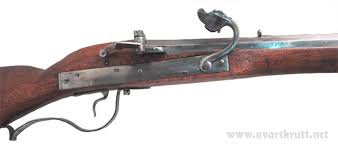Musket
You may have heard often about Musket. Don't you? What was musket? The Musket was a type of firearm that featured a long, smooth-bore barrel and fired either a musket ball or a Minie ball.
 The Musket was heavily developed during its centuries of use from 1400s to the late 1800s, with different types of musket evolving. The earliest reference to musket was found as early as in AD 1260 by the Chinese. Their gun was known as the 'Hand Cannon'. The device originally worked on explosion inside a musket barrel which was to be lighted before the firing ( with no mechanism ). Ultimately in the late 1400s a new mechanism developed which was the Matchlock Mechanism which made China the leader in the use of guns.
The Musket was heavily developed during its centuries of use from 1400s to the late 1800s, with different types of musket evolving. The earliest reference to musket was found as early as in AD 1260 by the Chinese. Their gun was known as the 'Hand Cannon'. The device originally worked on explosion inside a musket barrel which was to be lighted before the firing ( with no mechanism ). Ultimately in the late 1400s a new mechanism developed which was the Matchlock Mechanism which made China the leader in the use of guns. |
| Matchlock Mechanism |
 |
| Matchlock Mechanism |
In Europe Musket appeared around the 15th century. But over there the gun had a greater affect in decreasing the morale of the enemy by making loud noise rather than killing the enemy. The direct decedent of musket, The Arquebus was found the first time in Hungary in the 15th century. Arquebus was a smooth-bore, muzzle loaded, matchlock weapon due to which there came a new evolution in the European troops. The pike-mans wore nearly about 15 kg of armour but with the arrival of the arquebus their armor was raised to 25 kg as Arquebus could penetrate 15 kg of armour.
 |
| Flintlock Mechanism |
Now the time came when the matchlock mechanism got replaced by the wheellock mechanism. The wheellock mechanism produced a spark by spinning a steel wheel which lighted the explosives in the barrel thus forcing the musket ball or minie ball out of the barrel. This was a huge triumph over the matchlock mechanism as now the muskets would be capable of self-ignition. However a new mechanism called the flintlock mechanism came to dominate the next evolution of the muskets thus the wheellock mechanism soon disappeared.
The earliest rifles with flintlock mechanism appeared nearly 1750 in Europe with new units that used them known by the vernacular name as 'Jagers' meaning 'Riflemen'. The flintlock mechanism was made by Swede Sven Aderman. The flintlock mechanism used a piece of flint held in the hammer which would strike a steel plate above the flash pan when the hammer was pulled igniting the powder in the flash pan which would then ignite the charge. Famous examples of the flintlock musket include the British Brown Bess (the longest serving firearm in history) and the Charleville Musket (which would form the basis of other designs for well over a century)  |
| British Brown Bess |
The Flintlock would eventually be replaced, after nearly 200 years of use, by the cap/percussion lock, which used a percussion cap (struck by the hammer) to ignite the powder charge, rather than the sparks of the flintlock mechanism. Along with the percussion lock mechanism came, almost immediately, the Rifled Musket using a rifled barrel to use (from 1847) the Minie Ball, designed specifically for use in rifled barrels, greatly improving accuracy. |
| Percussion lock |
The era of the musket ended with the emerging use of breechloading rifles, which began to appear in the 1840s (the Norwegian made Kammerlader and Prussian Dreyse Needle Gun to name two of the earliest widely used examples). Although the M1819 Hall rifle had been developed in the 1810s, it was not until the Dreyse Needle Gun dominated the Austro-Prussian War in 1866 that the breechloading rifle came into the fore. Thus the era of musket ended. However, Musket became the world's most used gun which dominated the world for more than five centuries. |
| Dreyse Needle Gun |
Also see - Cannon
No comments:
Post a Comment